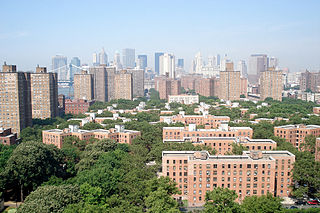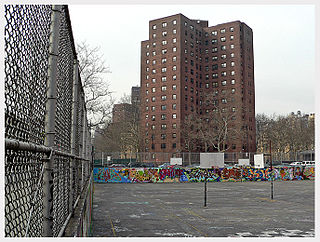
Avenue D is the easternmost named avenue in the East Village neighborhood of Manhattan, New York City, east of Avenue C and west of the FDR Drive. It runs between East 13th and Houston Streets, and continues south of Houston Street as Columbia Street until Delancey Street and Abraham Kazan Street until its end at Grand Street. Avenues A, B, C and D are the origin of the name of the section of the East Village neighborhood through which they run, Alphabet City.

Two Bridges is a neighborhood in the New York City borough of Manhattan, nestled at the southern end of the Lower East Side and Chinatown on the East River waterfront, near the footings of the Brooklyn Bridge and Manhattan Bridge. The neighborhood has been considered to be a part of the Lower East Side for much of its history. Two Bridges has traditionally been an immigrant neighborhood, previously populated by immigrants from Europe, and more recently from Latin America and China. The Two Bridges Historic District was listed in the National Register of Historic Places in September 2003.

Senator Robert F. Wagner Houses, also known as Triborough Houses, is a public housing development in the East Harlem neighborhood of Manhattan, in New York City and is administered by the New York City Housing Authority. It is located east of Second Avenue in the northeast corner of Manhattan, consists of fourteen 16-story buildings and eight 7-story buildings, a total of 22 buildings. It has 5,290 residents who live in 2,162 apartments. The complex occupies 26.91 acres (10.89 ha). It cost $30,926,000 to construct.

The Robert Fulton Houses is a housing project located in the Chelsea neighborhood in the New York City Borough of Manhattan and is owned and operated by the New York City Housing Authority (NYCHA). The 6.27-acre (2.54 ha) site is located between West 16th and 19th Streets and bounded by Ninth and Tenth Avenues. The project consists of 945 apartments in eleven buildings; three of the developments are 25 stories, while the others are 6 stories high.
Manhattanville Houses is a public housing project in the Manhattanville section of West Harlem, in the borough of Manhattan, New York City. The project is located between Broadway and Amsterdam Avenue, spanning a superblock from 129th Street to 133rd Street and are managed by the New York City Housing Authority. The project consists of six 20-story buildings containing 1,272 apartment units.

The Jacob Riis Houses are a public housing project managed by the New York City Housing Authority (NYCHA) in the East Village in New York City. The project is located between Avenue D and the Franklin D. Roosevelt Drive, spanning two superblocks from 6th Street to 13th Street. The project consists of thirteen buildings, between six and 14 stories each, containing 1,191 apartment units.

The Stanley M. Isaacs Houses is a public housing project for those of low-to-moderate incomes located just south of 96th street in the Manhattan neighborhood of Yorkville. The Isaacs Houses and the Holmes Towers borders East Harlem, which has the highest concentration of public housing in the United States. The three public housing buildings in the Yorkville neighborhood of Manhattan in New York City, are 24 stories tall and contain 635 apartments. The project is located between 93rd and 95th Streets with playground & ball courts from 95th-97th street, stretching from 1st Avenue to the FDR Drive.

Governor Alfred E. Smith Houses, or the Alfred E. Smith Houses. is a public housing development built by the New York City Housing Authority in the Two Bridges neighborhood of the Lower East Side of Manhattan. There are 12 buildings in the complex; all are 17 stories tall. It covers 21.75 acres (8.80 ha), has 1,931 apartments, and houses an estimated 5,739 people. The grounds are bordered by St. James Place to the west, Madison Street to the north, Catherine Street to the east, and South Street to the south.

Bernard M. Baruch Houses, or Baruch Houses, is a public housing development built by the New York City Housing Authority (NYCHA) on the Lower East Side of Manhattan. Baruch Houses is bounded by Franklin D. Roosevelt East River Drive to the east, E. Houston Street to the north, Columbia Street to the west, and Delancey Street to the south. The complex, the largest NYCHA development in Manhattan, occupies 27.64 acres (111,900 m2), of which buildings cover 13.4%, a percentage similar to that of most "tower in the park" project designs. It has 2,194 apartments, which house an estimated 5,397 people. These apartments are distributed throughout 17 buildings. Baruch Houses I is seven stories tall, Baruch Houses XI, XIII, and XV are thirteen stories tall, and the rest (II-X,XII,XIV,XVI-XVII) are fourteen stories tall. Combined, these buildings have 2,900,000 square feet (270,000 m2).
Bracetti Plaza, or Mariana Bracetti Plaza, is a public housing development built and maintained by the New York City Housing Authority in Alphabet City, a section of the East Village neighborhood of Manhattan. The development is named after Mariana Bracetti (1825-1903), a legendary Puerto Rican woman who was known as the "Arms of Gold", and who was the first to craft the Boriquas Latin Cross, Puerto Rico's first flag. The flag was designed by Dr. Ramon Emeterio Betances, and is still a symbol of the Puerto Rican independence movement.

Mayor Fiorello H. LaGuardia Houses, also known as LaGuardia Houses, is a public housing development built and maintained by the New York City Housing Authority (NYCHA) on the Lower East Side of Manhattan. Mayor Fiorello H. LaGuardia Houses is composed of thirteen buildings, all of which are sixteen stories tall. The buildings have 1,093 apartments and house approximately 2,596 people. The complex occupies 10.96 acres (4.44 ha), and is bordered by Madison Street to the north, Montgomery Street to the east, Cherry Street to the south, and Rutgers Street to the west. LaGuardia Houses Addition is a sixteen-story tower for elderly people at the corner of Jefferson Street and Cherry Street.

Rutgers Houses, also known as Henry Rutgers Houses, is a public housing development built and maintained by the New York City Housing Authority (NYCHA) on the Lower East Side of Manhattan. Rutgers Houses is composed of five 20 story buildings on 5.22 acres (21,100 m2), with 721 apartments housing approximately 1,675 people. The complex is bordered by Madison Street to the north, Rutgers Street to the east, Cherry Street to the south, and Pike Street to the west.

Vladeck Houses is a public housing development built and maintained by the New York City Housing Authority on the Lower East Side of Manhattan. The development is named after Baruch Charney Vladeck, who was general manager of The Jewish Daily Forward, a Yiddish language newspaper, helped found the Jewish Labor Committee in 1934, served as its first president, and was a member of the original board of the New York City Housing Authority.

Carver Houses, or George Washington Carver Houses, is a public housing development built and maintained by the New York City Housing Authority (NYCHA) in Spanish Harlem, a neighborhood of Manhattan, at.
Governor DeWitt Clinton Houses, also known as DeWitt Clinton Houses or Clinton Houses, is a public housing development built and maintained by the New York City Housing Authority (NYCHA) in the Spanish Harlem neighborhood of Manhattan. Clinton Houses is composed of six buildings, resting on a non-continuous campus with an area of 5.6 acres (23,000 m2). Five of those (I-V) are 18 stories high, and another (VI) is nine stories high. The six buildings have a total of 749 apartments, which house 1,823 people. Clinton Houses occupies the two blocks that are bordered by East 110th Street to the north, Lexington Avenue to the east, Park Avenue to the west, and East 108th Street to the south. It also occupies the western half of the two blocks that are bordered by East 106th Street to the north, Lexington Avenue to the east, Park Avenue to the west, and East 104th Street to the south, with the exception of a small part along East 106th Street.

The Farragut Houses is a public housing project located in the downtown neighborhood of northwestern Brooklyn, New York City, bordering the Brooklyn Navy Yard. Farragut Houses is a property of New York City Housing Authority (NYCHA). The houses contain 3,272 residents who reside in ten buildings that are each 13 to 14 stories high.




















